-----
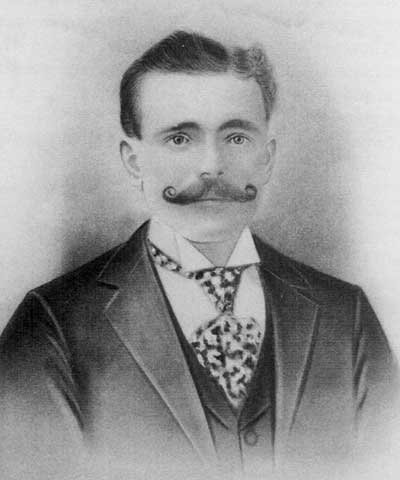 |
| Perley A. Thomas. Designer, draftsman, and moustache master. (Transportation History) |
Perley A. Thomas was born in 1874 at a farm outside of Chatham, Ontario, and grew up there until 1901, when he moved to Detroit, Michigan. He proved to be highly adept at structural engineering and design, which earned him the the notice of the Kuhlman Car Company in Cleveland, Ohio, and the Southern Car Company in High Point, North Carolina. He accepted the latter's offered position as chief engineer, draftsman, and designer in 1909 and propelled the company into making fabulous wood and steel streetcars. However, success was brief as the company folded in 1916, unable to keep up with the likes of St. Louis and American Car Company, and Thomas found himself laid off. Still wanting to be in the streetcar business, he was persuaded to accept a contract from the Southern Public Utilities Company to renovate their streetcars operating in Winston Salem, North Carolina. 30 of the original Southern Car Company employees stayed with Thomas, as did the original facilities in High Point, so it was quite easy to formally organize the Perley A. Thomas Car Works in 1917.
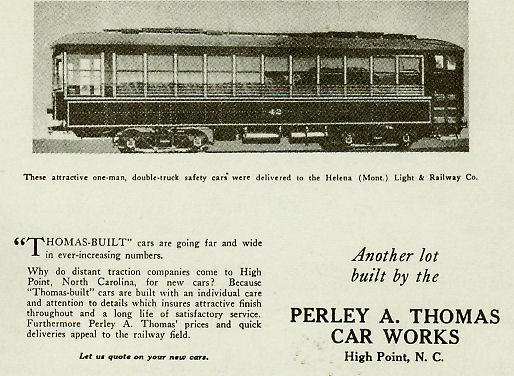 |
| An advertisement for the Perley Car Company from 1924. (Mid-Continent Railway Museum) |
Work started slowly for the new company, renovating streetcars for Montgomery and Mobile, Alabama, but 1918 saw the first production of new steel streetcars and a major factory expansion to allow simultaneous production and renovation. Perley Thomas and his engineers and designers began creating cars all over the Midwest and the Eastern Seaboard from New York City to Miami, Florida, and even as far down as San Juan, Puerto Rico, and Havana, Cuba. This popularity earned the notice of the NOPSI, who was looking to standardize their fleet of old horsecars and open-deck streetcars, and they contracted Perley A. Thomas to produce a standard fleet that ended up being the largest order the car works had ever seen (so large, they had to contract a portion to competitor J.G. Brill).
 |
| Interior of an original Perley car on the Riverfront Route. (Infrogmation) |
Designated the 800-900 series, the new steel streetcars were impressively contemporary. Their high ceiling and maximum capacity of 52 people made for a light, airy experience while the flat river basin of New Orleans ensured the two 65-hp GE263 motors never had to work too hard to propel the 21-ton streetcar along its various routes. These cars ended up being dubbed "Perleys" due to their manufacturer, and 98 would be constructed by Perley A. Thomas between 1921 and 1924. Due to the immense workload, Brill built the other 75 but unlike most split orders, there doesn't appear to be any major differences between the two.
Perley A. Thomas itself suffered a setback in production in September 1922 when a fire struck the High Point factory and destroyed 14 cars bound for New Orleans. The company rebuilt quickly and added a new shop track to allow 9 cars to be produced at once. With a shop force of 125 people, Perley A. Thomas could outshop seven complete cars a week on average. New Orleans was very pleased with its new streetcars, but this high point would again not last long for Perley A. Thomas. Changing trends meant transit companies were no longer buying streetcars, and the company had to retool by 1930, when the last four streetcars bound for Mobile, Alabama ended all production in favor of buses.
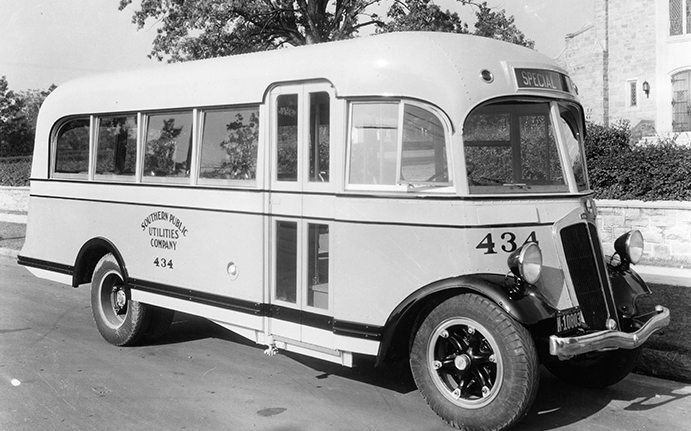 |
| One of the original Thomas-Built transit buses built for the Duke Power Co, 1934. (Thomas Built Buses) |
1936 saw Perley A. Thomas' transformation into the company we all know today as Thomas Built Buses. That year, Perley A. Thomas and Hackney Brothers were in an intense bidding war for a contract to produce school buses for the state of North Carolina. The two ended up winning as they had to split a 500-body order between them, but the former streetcar builder saw soaring profits from five months of bus production. Though Mr. Thomas himself retired in 1940, he remained a president and design consultant for the company and saw its rise as a formidable force in school bus production. Mr. Thomas died in 1958, aged 84, always ever the design consultant, and Thomas Built Buses was renamed in 1972, 42 years after the end of streetcar construction. It is currently owned by Daimler Trucks North America after three generations of family ownership.
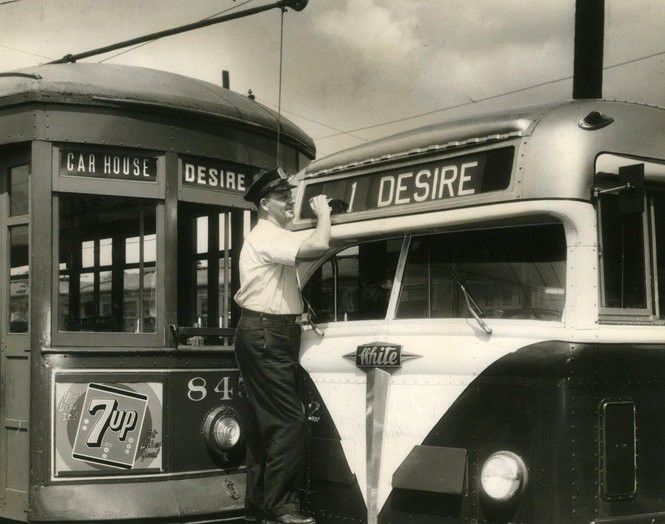 |
| An operator changes the headboard on a new White Bus for the Desire Streetcar Line, as an irate No. 845 judges him. (NOLA.com) |
Meanwhile in New Orleans, the po'boys (out of work, "poor" motormen, whose nickname during a 1929 strike were passed to the baguette sandwiches offered to them) continued operating their Perley cars when all other transit systems had upgraded to modern PCCs or light rail vehicles. Even with the onset of buses, the Perleys kept plying their trade on the St. Charles Avenue line, and a shout-out in Tennessee William's A Streetcar Named Desire only furthered their nostalgic romance. By the 1960s, at a time when most streetcar systems had fallen for scrap, 45 of the original 173 cars were secured for preservation. The others were deemed surplus to requirements (due to the reduction of lines) and scrapped.
 |
| A 900-class Perley being refurbished for RTA service. (Marty Bernard) |
35 cars remained in New Orleans under the new Regional Transit Authority (RTA), saw continued operation on the St. Charles Avenue Streetcar, then eventually the Riverfront, Canal, and Rampart Streetcar Lines. The RTA also established a parts shop that served as a mini-Perley A. Thomas Car Works to create spares, and even whole replicas for the Canal and Riverfront lines with fancy new tech like ADA compliance and air-conditioning. These new replicas were produced with the help of the Brookville Equipment Corporation, creating 31 2000- and 400-series cars with striking double-clerestory roofs. A case as to how tough the 35 original Perleys are can be made when one looks at how all 35 survived Hurricane Katrina completely unharmed, while the 31 Brookville-RTA replicas (due to their proximity on the Riverfront Line) had to be extensively rehabilitated until 2009.
 |
| One of the new 2000-series Perleys built by RTA and Brookville, showing off its distinctive double-clerestory hiding the A/C equipment and the inside-frame trucks recycled from Brookville's PCC trucks. (Free Tours by Foot) |
 |
| MUNI 952 (ex-NOPSI 952) at work on Market Street. Note the added MUNI dash sign. (besopha) |
The other ten found homes all around the country. San Francisco's Municipal Railway (MUNI) owns two of them under the Market Street Railway moving museum, with No. 952 being leased to Muni in 1998 after a period of operation on the Riverfront Line in 1984. Its sister car, 913, was originally preserved and restored by the Orange Empire Railway Museum, but was purchased by MUNI in 2005 for restoration. The historic factory town of Lowell, Massachusetts, also has an operating Perley in the form of No. 966, loaned from the Seashore Trolley Museum of Kennebunkport, Maine. This car was originally preserved in Alabama (who planned on restoring two other Perley cars) but when plans fell through, Seashore purchased the car and completely rebuilt it to operating condition.
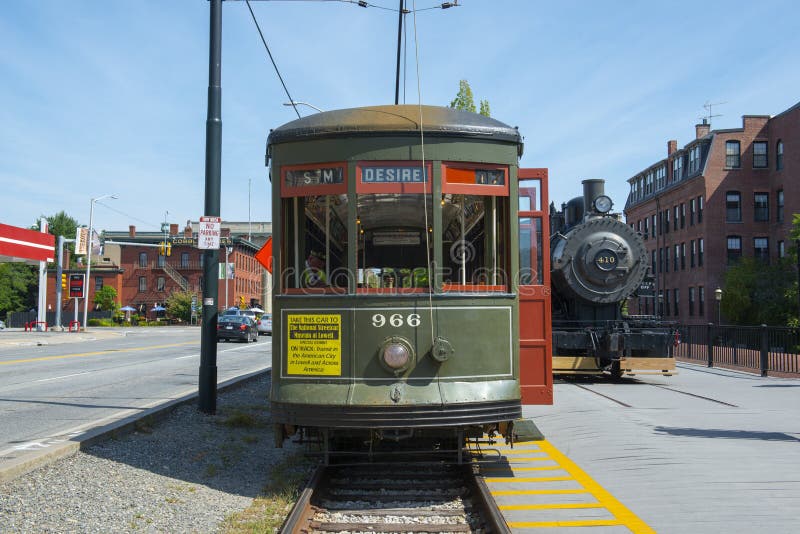 |
| Ex-NOPSI Streetcar No. 966 stops by B&M Switcher 410 in Lowell, MA. (Dreamstime) |
Though Perley A. Thomas may be gone, both the Thomas Built Bus Company and the 35 Perleys still working in New Orleans continue to honor his legacy. His trolley cars are both functional and have classic forms that are about as identifiable to the Big Easy as a sugar-frosted beignet or a "second line" jazz funeral. Their olive-drab color and no-frills aesthetic makes them look antiquated, but that also makes them look utterly timeless, and all over the United States they are all still identified as "The Streetcar Named Desire." As they now reach 100 years old, the Perleys seem to have no intention of stopping, and if jazz is the beating heart of New Orleans, then its streetcars must be the flow that keeps it beating.
 |
| Two generations of Perley Cars meeting on the Canal Streetcar Line. (Destination360) |
-----

No comments:
Post a Comment